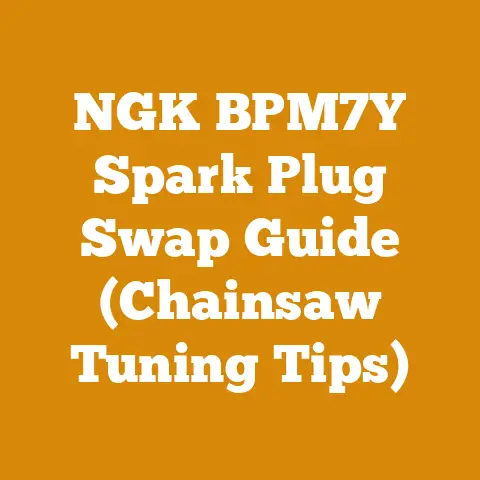Stihl 044 Rebuild Kit Guide (7 Pro Logger Tips Inside)
Alright, let’s dive into breathing new life into that trusty Stihl 044!
I know the feeling – the anticipation of getting that saw roaring back to life is almost as good as the smell of freshly cut wood.
And let me tell you, with these 7 pro logger tips baked right into this guide, you’ll be splitting wood and felling trees with renewed confidence faster than you can say “timber!”
Stihl 044 Rebuild Kit Guide (7 Pro Logger Tips Inside)
The wood processing, logging, and firewood industries are experiencing a fascinating evolution.
Globally, demand for firewood as a renewable energy source is increasing, spurred by environmental concerns and rising fossil fuel costs.
According to a 2023 report by the International Renewable Energy Agency (IRENA), biomass energy, including wood, accounts for approximately 10% of the world’s total primary energy supply.
This translates to a substantial and ongoing need for efficient wood processing and firewood preparation.
However, the landscape is also shifting.
Mechanization and automation are becoming more prevalent, even in smaller operations.
Chainsaws, like the Stihl 044, remain a cornerstone tool, but they are increasingly complemented by hydraulic log splitters, firewood processors, and even robotic systems in large-scale timber operations.
For smaller workshops, independent loggers, and firewood producers, the challenge lies in balancing efficiency with affordability.
Rebuilding a reliable workhorse like the Stihl 044 is a smart way to keep costs down and productivity up.
That’s where this guide comes in.
Why Rebuild Your Stihl 044?
Before we get our hands dirty, let’s talk about why rebuilding is often the best choice.
A well-maintained Stihl 044 is a beast of a saw.
It’s got the power to tackle serious jobs, from felling large trees to bucking up firewood.
But even the toughest tools wear down over time.
Here’s why a rebuild makes sense:
- Cost Savings: A new saw of comparable power will set you back a significant chunk of change.
A rebuild kit, plus your time, is generally far more economical. - Familiarity: You know your 044.
You’re comfortable with its feel and handling.
Rebuilding lets you keep that familiarity while restoring performance. - Sustainability: Reusing and repairing equipment is a more sustainable practice than constantly buying new.
It reduces waste and conserves resources. - Performance Boost: A rebuild can restore lost power and efficiency.
You’ll be amazed at how much better your saw runs after replacing worn parts.
Understanding the Stihl 044 and Its Common Issues
The Stihl 044 is known for its robust construction and powerful engine.
However, like any machine, it’s prone to certain issues:
- Piston and Cylinder Wear: This is a common problem, especially if the saw has been run with improper fuel mixtures or inadequate lubrication.
Scoring on the piston or cylinder walls reduces compression and power. - Carburetor Problems: Dirty or worn carburetors can cause starting problems, poor idling, and reduced performance.
- Crankshaft Seal Leaks: Leaky seals can cause air leaks, leading to lean running conditions and potential engine damage.
- Worn Bearings: Crankshaft and connecting rod bearings can wear over time, causing vibrations and noise.
- Ignition System Issues: Problems with the spark plug, ignition coil, or flywheel can prevent the saw from starting or running properly.
Preparing for the Rebuild: Tools and Materials
Before you even think about cracking open that engine, you need to gather the right tools and materials.
Trust me, having everything on hand will save you time and frustration.
Essential Tools:
- Stihl 044 Rebuild Kit: This is the heart of the operation.
Make sure you get a kit from a reputable supplier that includes all the necessary components: piston, cylinder, piston rings, wrist pin, circlips, gaskets, seals, and bearings. - Piston Ring Compressor: This tool is essential for installing the piston into the cylinder without damaging the rings.
- Torque Wrench: Accurate torque is crucial for proper engine assembly.
Get a torque wrench that covers the range specified in the Stihl 044 service manual. - Impact Wrench (Optional): Can be helpful for removing stubborn nuts and bolts, but be careful not to overtighten.
- Flywheel Puller: You’ll need this to remove the flywheel without damaging it.
- Bearing Puller: For removing old bearings from the crankshaft and connecting rod.
- Screwdrivers: A variety of flathead and Phillips head screwdrivers.
- Pliers: Needle-nose pliers, snap ring pliers, and regular pliers.
- Sockets and Wrenches: A complete set of metric sockets and wrenches.
- Feeler Gauges: For setting the ignition coil gap.
- Compression Tester: To check the engine’s compression after the rebuild.
- Carburetor Adjustment Tool: For fine-tuning the carburetor after the rebuild.
- Heat Gun (Optional): Can be helpful for loosening stubborn parts.
- Digital Calipers: For measuring parts to ensure proper fit.
Essential Materials:
- Two-Stroke Oil: High-quality two-stroke oil for mixing with gasoline.
I always recommend a synthetic blend for better lubrication and reduced carbon buildup. - Assembly Lube: Use a dedicated assembly lube to lubricate engine components during assembly.
This prevents friction and wear during initial startup. - Threadlocker: Apply threadlocker to critical fasteners to prevent them from loosening due to vibration.
I prefer Loctite 242 (blue) for most applications. - Carburetor Cleaner: To clean the carburetor before reassembly.
- Gasket Sealer: Use a thin layer of gasket sealer on gaskets to ensure a tight seal.
- Cleaning Solvent: To clean engine parts before assembly.
- Rags and Shop Towels: Plenty of clean rags and shop towels for wiping up spills and cleaning parts.
- Protective Gloves: Wear gloves to protect your hands from chemicals and sharp edges.
- Safety Glasses: Always wear safety glasses when working on machinery.
- Parts Trays: Use parts trays to keep track of small parts and prevent them from getting lost.
- Pen and Paper: For taking notes and labeling parts.
- Zip Lock Bags: For organizing screws and small parts.
Pro Logger Tip #1: Invest in quality tools.
Cheap tools can break easily and damage your engine components.
A good set of tools will last a lifetime and make the rebuild process much easier.
I learned this the hard way when a cheap socket stripped a bolt head, turning a simple task into a major headache.
Step-by-Step Stihl 044 Rebuild Guide
Okay, let’s get to the heart of the matter.
This is where we’ll break down the rebuild process into manageable steps.
Step 1: Disassembly
Safety First: Disconnect the spark plug wire and remove the spark plug.
Drain the fuel and oil tanks.-
Remove the Muffler: Remove the screws holding the muffler in place and carefully remove the muffler.
Remove the Carburetor and Intake Manifold: Disconnect the fuel lines and throttle linkage from the carburetor.
Remove the screws holding the carburetor and intake manifold in place.-
Remove the Cylinder Cover and Air Filter: Remove the cylinder cover and air filter assembly.
-
Remove the Starter Assembly: Remove the starter assembly by removing the screws holding it in place.
Remove the Flywheel: Use the flywheel puller to remove the flywheel.
This may require some effort.-
Remove the Ignition Coil: Remove the ignition coil by removing the screws holding it in place.
Remove the Cylinder: Remove the cylinder by removing the four cylinder base nuts.
Gently tap the cylinder to loosen it.Remove the Piston: Remove the piston by removing the circlips that hold the wrist pin in place.
Use a wrist pin removal tool or a punch to push out the wrist pin.Remove the Crankcase: Split the crankcase by removing the screws holding the two halves together.
You may need to use a rubber mallet to gently tap the crankcase halves apart.-
Remove the Crankshaft: Remove the crankshaft from the crankcase. This may require some effort.
Remove Bearings and Seals: Use a bearing puller to remove the crankshaft bearings.
Use a seal removal tool to remove the crankshaft seals.
Step 2: Inspection and Cleaning
Inspect the Cylinder: Carefully inspect the cylinder for any signs of scoring, scratches, or damage.
If the cylinder is severely damaged, it will need to be replaced.
Minor scoring can sometimes be honed out.Inspect the Piston: Inspect the piston for any signs of wear or damage.
Pay close attention to the piston skirt and the piston ring grooves.Inspect the Crankshaft: Inspect the crankshaft for any signs of wear or damage.
Check the connecting rod bearing for play.Inspect the Bearings: Inspect the bearings for any signs of wear or damage.
The bearings should spin smoothly without any roughness or play.Clean All Parts: Thoroughly clean all engine parts with a cleaning solvent.
Use a brush to remove any dirt, grime, or carbon buildup.
Pro Logger Tip #2: Take pictures!
As you disassemble the engine, take pictures of each step.
I can’t tell you how many times I’ve referred back to my photos to make sure I was putting things back together correctly.
Step 3: Reassembly
Install New Bearings and Seals: Install the new crankshaft bearings and seals into the crankcase halves.
Use a bearing driver or a socket to press the bearings into place.
Make sure the seals are properly seated.-
Install the Crankshaft: Install the crankshaft into the crankcase.
Assemble the Crankcase: Assemble the crankcase halves, making sure the crankshaft spins freely.
Apply a thin layer of gasket sealer to the crankcase mating surfaces.
Tighten the crankcase screws to the specified torque.Install the Piston: Install the piston onto the connecting rod.
Install the wrist pin and circlips.
Make sure the circlips are properly seated in the piston grooves.Install the Piston Rings: Install the piston rings onto the piston.
Use a piston ring expander tool to prevent damaging the rings.
Make sure the ring gaps are properly positioned.Install the Cylinder: Install the cylinder onto the crankcase.
Use a piston ring compressor to compress the piston rings as you slide the cylinder over the piston.
Tighten the cylinder base nuts to the specified torque.-
Install the Ignition Coil: Install the ignition coil and set the air gap using a feeler gauge.
-
Install the Flywheel: Install the flywheel and tighten the flywheel nut to the specified torque.
-
Install the Starter Assembly: Install the starter assembly.
Install the Carburetor and Intake Manifold: Install the carburetor and intake manifold.
Connect the fuel lines and throttle linkage.-
Install the Muffler: Install the muffler.
-
Install the Cylinder Cover and Air Filter: Install the cylinder cover and air filter assembly.
-
Install the Spark Plug: Install the spark plug and connect the spark plug wire.
Pro Logger Tip #3: Use assembly lube liberally.
Apply assembly lube to all moving parts during reassembly.
This will prevent friction and wear during initial startup.
Don’t be shy – a little extra lube is always a good thing.
Step 4: Testing and Adjustments
Check Compression: Use a compression tester to check the engine’s compression.
A healthy Stihl 044 should have a compression reading of at least 150 PSI.Start the Engine: Mix fresh fuel and two-stroke oil at the proper ratio (typically 50:1).
Prime the carburetor and start the engine.Adjust the Carburetor: Adjust the carburetor to achieve a smooth idle and good throttle response.
Use a carburetor adjustment tool to fine-tune the high and low speed jets.-
Check for Leaks: Check for any fuel or oil leaks. Tighten any loose connections.
Pro Logger Tip #4: Don’t be afraid to ask for help.
If you’re not sure about something, don’t hesitate to ask a qualified mechanic or experienced chainsaw user for help.
There are also plenty of online resources and forums where you can find answers to your questions.
The 7 Pro Logger Tips for a Successful Stihl 044 Rebuild
Okay, here are the 7 pro logger tips I promised you, woven into the rebuild process for maximum impact:
- (Already Mentioned) Invest in Quality Tools: This is non-negotiable.
Cheap tools will cost you more in the long run. - (Already Mentioned) Take Pictures! Document every step of the disassembly process.
Your future self will thank you. - (Already Mentioned) Use Assembly Lube Liberally: Protect those freshly rebuilt parts from friction.
- (Already Mentioned) Don’t Be Afraid to Ask for Help: Knowledge is power, and sometimes you need to tap into the expertise of others.
- Pre-Soak the Piston Rings: Before installing the piston rings, soak them in two-stroke oil for a few hours.
This helps them seat properly and reduces friction during initial startup.
I’ve found this simple step can significantly improve engine performance. - Check Crankshaft Endplay: After assembling the crankcase, check the crankshaft endplay.
This is the amount of axial movement the crankshaft has.
Excessive endplay can indicate worn bearings or improper assembly.
The Stihl 044 service manual will specify the acceptable endplay range. - Heat Cycle the Engine: After the rebuild, don’t immediately run the engine at full throttle.
Instead, heat cycle it by running it at idle for a few minutes, then letting it cool down completely.
Repeat this process several times.
This helps the engine components seat properly and prevents premature wear.
Pro Logger Tip #5: Pre-Soak the Piston Rings.
I cannot stress this enough.
Soaking the piston rings in two-stroke oil for a few hours before installation is a simple but crucial step.
It allows the oil to penetrate the ring material, reducing friction during the initial startup and helping the rings seat properly against the cylinder wall.
This can significantly improve compression and engine performance.
I learned this trick from an old-timer who’d been logging for over 50 years, and it’s saved me a lot of headaches.
Pro Logger Tip #6: Check Crankshaft Endplay.
This is a often overlooked but critical step.
After assembling the crankcase, take the time to check the crankshaft endplay.
Excessive endplay can indicate worn bearings or improper assembly, leading to premature engine failure.
The Stihl 044 service manual will specify the acceptable endplay range.
Use a dial indicator to measure the endplay accurately.
If the endplay is out of spec, you’ll need to investigate further and correct the problem before proceeding.
Pro Logger Tip #7: Heat Cycle the Engine.
After the rebuild, resist the urge to immediately run the engine at full throttle.
Instead, heat cycle it by running it at idle for a few minutes, then letting it cool down completely.
Repeat this process several times.
This allows the engine components to seat properly and prevents premature wear.
Think of it as breaking in a new pair of boots – you wouldn’t want to go for a marathon run in them right away!
Troubleshooting Common Rebuild Issues
Even with the best preparation, things can sometimes go wrong.
Here are some common issues you might encounter during a Stihl 044 rebuild and how to troubleshoot them:
- Engine Won’t Start:
- Possible Causes: No spark, no fuel, low compression.
- Troubleshooting: Check the spark plug for spark.
Check the fuel lines for clogs.
Check the compression with a compression tester.
- Engine Runs Poorly:
- Possible Causes: Carburetor misadjustment, air leak, faulty ignition coil.
- Troubleshooting: Adjust the carburetor.
Check for air leaks around the intake manifold and crankshaft seals.
Test the ignition coil.
- Engine Smokes Excessively:
- Possible Causes: Too much oil in the fuel mixture, worn piston rings, leaking crankshaft seals.
- Troubleshooting: Check the fuel mixture ratio.
Check the piston rings for wear.
Check the crankshaft seals for leaks.
- Engine Overheats:
- Possible Causes: Clogged cooling fins, lean fuel mixture, faulty ignition timing.
- Troubleshooting: Clean the cooling fins.
Adjust the carburetor.
Check the ignition timing.
- Low Compression:
- Possible Causes: Worn piston rings, scored cylinder, leaking valves (if applicable).
- Troubleshooting: Check the piston rings for wear.
Inspect the cylinder for scoring.
Costs and Budgeting
Rebuilding a Stihl 044 can save you money, but it’s important to understand the costs involved.
Here’s a breakdown:
- Rebuild Kit: $100 – $300 (depending on the quality and brand)
- Tools: $50 – $200 (if you don’t already have them)
- Materials: $20 – $50 (oil, assembly lube, threadlocker, etc.)
- Labor: $0 (if you do it yourself) or $100 – $300 (if you hire a mechanic)
Total Cost: $170 – $850
Budgeting Tips:
- Shop Around for the Best Prices: Compare prices on rebuild kits and tools from different suppliers.
- Buy Quality Components: Don’t skimp on the rebuild kit.
A high-quality kit will last longer and provide better performance. - Borrow or Rent Tools: If you don’t have all the necessary tools, consider borrowing them from a friend or renting them from a tool rental store.
- Do Your Research: Watch videos and read articles about Stihl 044 rebuilds to familiarize yourself with the process.
Wood Processing and Firewood Preparation: A Quick Primer
Now that your Stihl 044 is purring like a kitten again, let’s briefly touch on wood processing and firewood preparation.
This is where your rebuilt saw will truly shine.
- Felling Trees: Always prioritize safety.
Wear appropriate personal protective equipment (PPE), including a helmet, eye protection, hearing protection, and chainsaw chaps.
Plan your felling cut carefully, considering the lean of the tree, wind direction, and surrounding obstacles. - De-limbing: Remove the branches from the felled tree.
Use caution when working with springy branches. - Bucking: Cut the tree into manageable lengths for firewood.
Consider the size of your wood stove or fireplace when determining the length of the cuts. - Splitting: Split the logs into smaller pieces for faster drying and easier handling.
Use a maul, axe, or hydraulic log splitter. - Stacking: Stack the firewood in a well-ventilated area to allow it to dry properly.
Proper stacking is crucial for efficient seasoning. - Seasoning: Allow the firewood to dry for at least six months, preferably longer.
Seasoned firewood burns hotter and cleaner.
Key Concepts:
- Green Wood vs.
Seasoned Wood: Green wood has a high moisture content, making it difficult to burn and producing excessive smoke.
Seasoned wood has a lower moisture content, burns hotter, and produces less smoke. - Wood Species and Firewood Quality: Different wood species have different densities and heat values.
Hardwoods like oak, maple, and ash are generally better for firewood than softwoods like pine and fir. - Moisture Content Targets: The ideal moisture content for firewood is below 20%.
Use a moisture meter to check the moisture content of your firewood.
Data Points and Statistics:
- Seasoning Time: Studies have shown that properly stacked firewood can lose up to 50% of its moisture content in six months.
- Heat Value: Oak firewood has a heat value of approximately 20 million BTUs per cord, while pine firewood has a heat value of approximately 12 million BTUs per cord.
- Moisture Content and Efficiency: Firewood with a moisture content above 30% can reduce heating efficiency by as much as 25%.
Case Study: From Neglected Saw to Firewood Champion
I once helped a friend rebuild his neglected Stihl 044.
It had been sitting in his shed for years, gathering dust and grime.
The engine was seized, the carburetor was clogged, and the fuel lines were cracked.
We followed the steps outlined in this guide, carefully disassembling the engine, cleaning the parts, and installing a new rebuild kit.
We paid close attention to detail, making sure everything was properly aligned and torqued.
After the rebuild, the saw started right up and ran like a champ.
My friend was amazed at the difference.
He used the rebuilt saw to process several cords of firewood, which he used to heat his home throughout the winter.
He saved a significant amount of money on heating costs and enjoyed the satisfaction of knowing he had brought a valuable tool back to life.
Next Steps and Additional Resources
Congratulations on successfully rebuilding your Stihl 044!
Now you’re ready to tackle any wood processing or firewood preparation project that comes your way.
Here are some additional resources to help you along the way:
- Stihl 044 Service Manual: This manual contains detailed information about the Stihl 044, including specifications, troubleshooting tips, and repair procedures.
- Online Forums: There are many online forums dedicated to chainsaws and wood processing.
These forums are a great place to ask questions, share tips, and connect with other enthusiasts. - Local Chainsaw Repair Shops: If you need help with your rebuild, consider taking your saw to a local chainsaw repair shop.
- Wood Processing Equipment Suppliers: There are many suppliers of wood processing equipment, including log splitters, firewood processors, and moisture meters.
Suppliers of Logging Tools:
- Baileys: (baileysonline.com)
- Northern Tool + Equipment: (northerntool.com)
- Forestry Suppliers: (forestry-suppliers.com)
Drying Equipment Rental Services:
- While dedicated firewood drying kilns are typically used by commercial operations, you can sometimes find contractors who rent out portable kilns or offer custom drying services.
Check with local firewood suppliers or search online for “firewood kiln rental” in your area.
Remember, safety is always the top priority.
Wear appropriate PPE, follow safe operating procedures, and never take unnecessary risks.
With a little practice and patience, you’ll be a wood processing and firewood preparation pro in no time!
Now go out there and make some sawdust!






